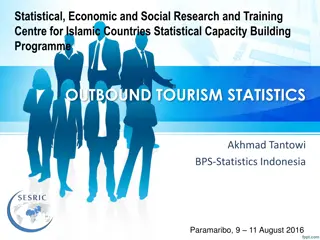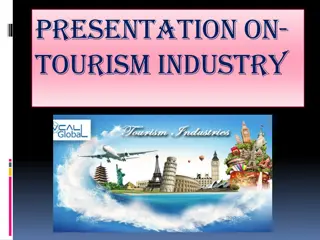Tourism Information Technology: Evolving Synergies for Strategic Applications
Delve into the world of tourism information technology with a focus on key concepts, definitions, characteristics of tourism services, applications of IT in the tourism industry, and typologies of information at different stages of a trip. Explore the evolution of information technology and its strategic implications for tourism organizations and destinations.
Download Presentation

Please find below an Image/Link to download the presentation.
The content on the website is provided AS IS for your information and personal use only. It may not be sold, licensed, or shared on other websites without obtaining consent from the author.If you encounter any issues during the download, it is possible that the publisher has removed the file from their server.
You are allowed to download the files provided on this website for personal or commercial use, subject to the condition that they are used lawfully. All files are the property of their respective owners.
The content on the website is provided AS IS for your information and personal use only. It may not be sold, licensed, or shared on other websites without obtaining consent from the author.
E N D
Presentation Transcript
2ndEdition Tourism Information Technology PIERRE J. BENCKENDORFF PAULINE J. SHELDON DANIEL R. FESENMAIER
Chapter 1 Introduction to Tourism and Information Technology
Chapter 1 Learning Objectives After studying this chapter you should be able to: 1. define key terms and concepts in information technology; 2. describe the evolution of information technology; 3. recognize the types of information technologies relevant to tourism; 4. explain the synergies between the travel industry and information technology; and 5. evaluate the strategic applications of information technology in tourism organizations and destinations.
Key Concepts Characteristics of tourism services Evolution of computing technologies Information systems Information technology Moore s Law Space-time collapse Typologies of information Web 1.0 / Web 2.0 4
Definitions Information technology (IT) The application of computers and telecommunications equipment to store, retrieve, transmit and manipulate data. (Daintith, 2012) Information systems Information systems are combinations of hardware, software and telecommunications networks that people build and use to collect, create, and distribute useful data, typically in organizational settings. (Valacich & Schneider, 2014)
Characteristics of Tourism Services Hetero- geneous Global Perishable Tourism Inseparable Intangible 6
Applications of IT in Tourism aviation travel intermediaries hospitality attractions, events and entertainment destinations travelers 7
Typologies of Information Trip Stage Pre-trip Static Brochures, guidebooks, fax, photos, videos, some information on websites Dynamic Phone, email, websites, social media, Internet booking engines, Global Distribution Systems In-trip Brochures, guidebooks, signs, maps, kiosks, TV channels in hotels, some mobile apps Phone, fax, email, websites, social media, mobile apps Post-trip Brochures, guidebooks, photos, video Blogs, social networks, media sharing, reviews 8
Evolution of Computing Technologies 30,000 BC 1800 1950 1900 1950 1975 2000 2025 Manual Counting Aids & Calculators Tally Bones Abacus Antikythera Mechanism Astrolabe Gutenberg Press Slide Rules Pascaline Mechanical Computers Punched Cards Arithometers Difference/Analytical Engines Typewriters Tabulators Electronic Computers Vacuum Tubes ENIAC Transistors UNIVAC I / IBM650 Integrated Circuits Mouse Spectra 70 / IBM360 Microprocessors Microcomputers GUI OS & Software Ubiquitous Technologies Mobile Phones IBM5100 / Osborne 1 Newton Smartphones Wifi iPod, iPhone, iPad Android App stores 1G, 2G, 3G, 4G Networks Mobile Social Networks Wearable Devices Networking & Internet ARPAnet Email Ethernet Internet WWW Web Browsers Search Engines Social Networks Broadband YouTube VoIP
Strategic Thinking & IT HIGH Airlines Defense Travel agent Banks PRODUCTION Hotels Tour operator Attractions Retailing High fashion Paper Lumber LOW HIGH MARKETING FIGURE 1.1 Impact of IT on the production and marketing of different industries.
Strategic Thinking & IT Managing Value Chains Managing Knowledge and Information Marketing and Competitive Advantage Service Delivery and Customer Relationship Management (CRM) Strategic Listening
PART I: UNDERSTANDING TOURISM IT FIGURE 1.2 Outline of Chapters CH 1 Introduction to Tourism and IT CH 2 The Digital Tourism Landscape THE TRIP PART II: LOOKING AND BOOKING CH 3 Travel Intermediaries and IT CH 4 The Internet and the Tourist CH 5 Social Media and Tourism PART III: TRAVELING PART IV: STAYING AND PLAYING CH 6 CH 9 Mobilities and IT Hospitality Information Systems CH 10 CH 7 Tourist Experiences and IT Aviation and IT CH 11 CH 8 Destination Management and IT Surface Transport and IT PART V: ISSUES AND TRENDS CH 12 Sustainable Tourism and IT CH 13 The Future of IT and Tourism
Discussion Questions 1. In your opinion, what are the three most important inventions that have led to the information technologies we have available today? Provide examples to justify your answer. Why is tourism such an information-intensive industry? Explain and give some examples. What is the difference between static and dynamic tourism information? Give examples of each. A hotel manager asks you why she should incorporate more technology into her hotel. How would you respond to this question so that they are inspired to invest? Identify one travel organization in your area that you think has used technology in a particularly creative way. Which of the strategic applications discussed at the end of the chapter would it fit into? Which part of the textbook (based on the diagram of the chapters) are you most looking forward to studying? Why? 2. 3. 4. 5. 6.
Useful Websites Eye for Travel http://www.eyefortravel.com/ International Federation for Tourism and Technology http://www.ifitt.org/ International Hospitality Information Technology Association http://hita.camp7.org/ Tnooz.com http://www.tnooz.com/ Travel Technology Initiative http://www.tti.org/ 15
Case Study Intercontinental Hotels Group Crowne Plaza, Holiday Inn, InterContinental Hotels. 4503 hotels and 656,661 rooms. Spends about $200 million annually on IT innovations (about 1.2% of revenue). The Atlanta Crowne Plaza Hotel s customer database holds 200 million guest profiles which can be mined for customer activity, trends and preferences. BOSS search technology: Google Integration GPS support and voice search iPhone and Google apps. Touchscreen kiosks in lobbies and concierge iPads. Camelot cloud computing environment.























